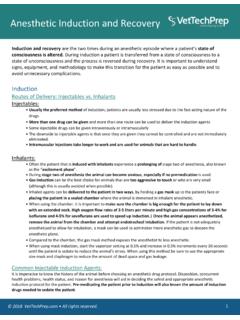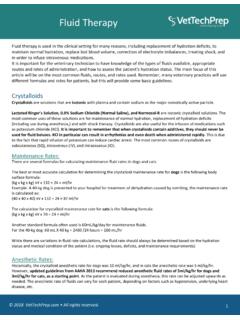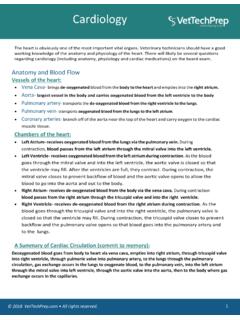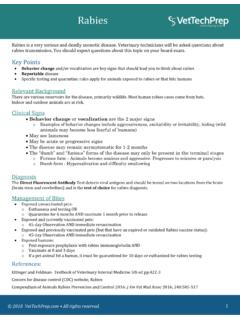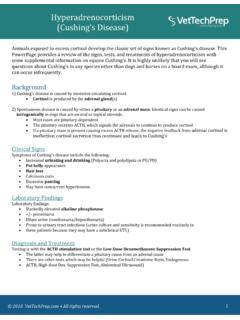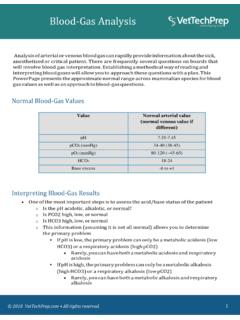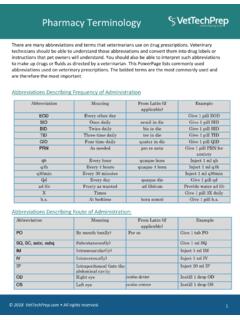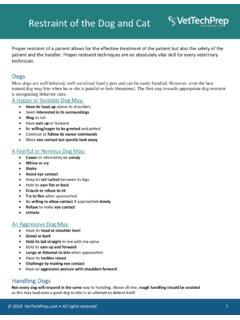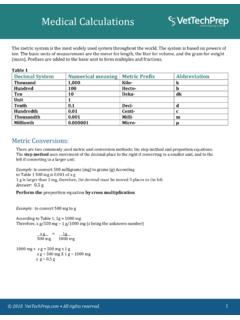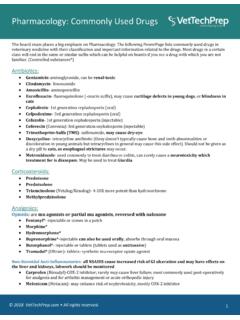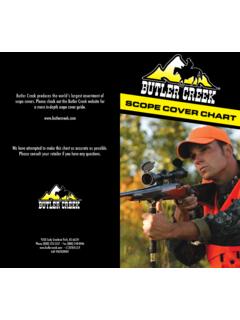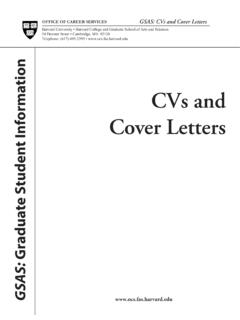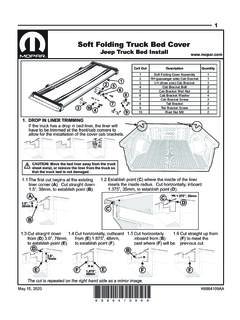Transcription of Surgery Prep: Scrubbing, Gloving, Gowning - VetTechPrep
1 Surgery Prep: Scrubbing, Gloving, Gowning Prepping for Surgery is an important task of the veterinary technician. Whether scrubbing into the Surgery to assist, or prepping the patient for the Surgery , the technician is largely responsible for ensuring that this is done following proper technique. This PowerPage discusses Surgery preparation including scrubbing, Gowning , and gloving techniques, and patient preparation for Surgery . Key Points: Closed gloving is recommended. If one must pass another person who is scrubbed in, they should pass each other back to back. Initial clip and a scrub to remove gross contamination should take place outside of the Surgery suite.
2 A minimum of 3 sterile scrubs and rinses to the surgical area are recommended for a surgical procedure. Scrubs should progress from proposed Surgery site and working in an outward fashion, not returning to the starting place with the same gauze. The two most used scrubs are povidone-iodine (Betadine), and chlorhexidine-gluconate (Nolvasan). Dorsal recumbency is on the back, sternal recumbency is on the belly, right or left lateral is on that side. When scrubbing in for Surgery , the scrub should last at least 5 minutes to maximize skin-to-soap contact time. All surfaces of the fingers, hand, forearms, and under the nails are scrubbed.
3 Scrubbing in for Surgery The point of scrubbing the hands and arms is to remove dirt and debris to decrease the amount of bacterial flora present. All jewelry should be removed, and nails should be short. After scrubbing has commenced, the hands and arms can no longer contact non-sterile objects. If this happens, the scrub is completely started over. Hands are held above elbow level during scrubbing. A soap-soaked sterile brush/sponge is used to start a systematic scrub technique. All four sides of each finger are scrubbed, and special attention to the fingernails should be taken as the area under the fingernails harbors the most bacteria.
4 The back, palm, and sides of the hand are scrubbed. Then the wrist and forearms are scrubbed, working toward the elbow. This scrubbing process is usually repeated again. After each scrub, the hands and arms are rinsed with running water so that the water runs down off the elbows and not back up to the hands. Initial scrubs for the day should last at least 5 minutes. Subsequent scrubs may require only 3 minutes. Some facilities will use this classic scrub technique for the first scrub of the day, and then use a waterless scrub (which is like a special hand sanitizer for surgical procedures) prior to Gowning and gloving for subsequent procedures.
5 Gloving and Gowning Surgical caps and masks are worn by all who are present in the Surgery room. Masks should be changed between procedures. All who are in the Surgery suite should also wear clean scrubs or a scrub suit. Street clothes and shoes are a source of contamination and should not be worn in the Surgery room. After the scrub has been performed, the hands and forearms are dried using a sterile towel. One side or end of the towel is generally used for drying one hand/arm, and then the towel is flipped to dry the other hand/arm without cross-contaminating. The arms are placed into the gown, but the arms are not brought through the gown arm holes until after the gloves are placed onto/over the sleeve ends.
6 This is called closed gloving and is preferred because the outside of the gloves never contacts the skin. After the glove is onto the sleeve, the arm is pushed through the hole and the hand into the sterile gloves. 2018 All rights reserved. 1 1 Surgery Prep: Scrubbing, Gloving, Gowning If gloves need replacement during Surgery , the gloves (along with the underlying sleeve) are pulled so that the arm once again is back up inside the sleeve, and the gloving procedure is repeated After a person is fully scrubbed in, the sterile area of the person is just below the neckline to the waist on the front side only.
7 Arms should never drop below the waist or sterility is considered broken. The back is considered non-sterile, so if one must pass someone who is scrubbed in, they should pass around the back, or two scrubbed-in persons should pass back to back. Sterile trays, drapes, or equipment should never be reached over by anyone not scrubbed-in. Patient Preparation Clipping the Patient: The Surgery site is clipped with adequate margins for the procedure to be performed. This is usually performed after anesthesia has been induced. In some cases (such as C-sections), the clipping of the Surgery site is performed before anesthesia in order to reduce the anesthesia time as much as possible.
8 For abdominal surgeries, the clip should extend a few centimeters cranial to the xiphoid, caudal to the pubis, and lateral to the nipples. If the Surgery area includes open wounds, a sterile water-soluble lubricant should be applied to them so that hair from the clipping does not contaminate and stick to the inside of the wound. The clean areas should be clipped first, and then the infected areas should be clipped. A vacuum cleaner is recommended for suctioning up the loose hair that has collected on and around the pet prior to scrubbing. Scrubbing the Patient: The initial scrub is done after the clipping in the preparation area to remove gross contamination.
9 Then the patient is moved into the Surgery room for final scrubbing. The prepuce of male dogs should be flushed with an antiseptic solution prior to surgical scrub of the abdomen. Sterile gloves are worn during the surgical scrub in the operating room to decrease contamination to the Surgery area from the hands. The most common antiseptic scrubs used for preparation are povidone-iodine (Betadine) or chlorhexidine (Nolvasan). The scrub is alternated with alcohol or saline. Contact time should be at least 5 minutes at the end of the 3 series of povidone-iodine scrubs. A minimum of three antiseptic scrubs should be performed at the proposed Surgery sites (a scrub and a rinse three times).
10 It should begin at the Surgery site itself and extend or progress in an outward fashion, never returning back to the center or proposed Surgery site with the same scrub gauze. Positioning for Surgery Abdominal surgeries are usually placed in dorsal recumbency (patient is on its back). The proper term for laying on the right side is right lateral recumbency. The proper term for laying on the left side is left lateral recumbency. Sternal recumbency is being placed with the sternum and abdomen down on the table (belly down). Many orthopedic surgeries involving the limbs use the hanging leg technique for preparation.
